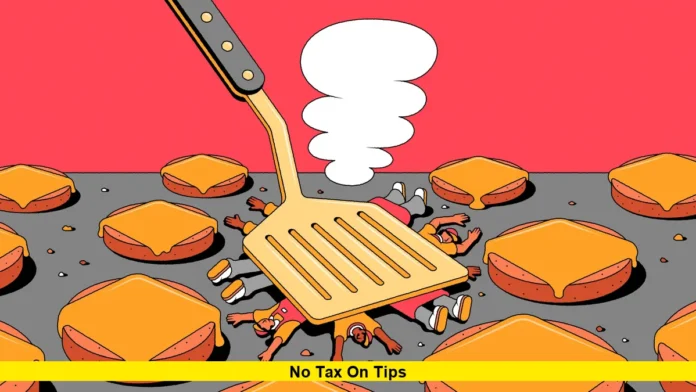The no tax on tips policy, signed into law by President Trump on July 4, 2025, has become a hot topic in restaurants, bars, and other service industry workplaces across the United States. Officially part of the One Big Beautiful Bill Act, the measure allows qualifying employees to deduct up to $25,000 in tip income from their federal income taxes.
On paper, this looks like a direct boost to tipped workers’ take-home pay, but as the details emerge, many are both hopeful and cautious about how it will play out in real life.
Table of Contents
Understanding the “No Tax on Tips” Policy
The no tax on tips provision applies to employees who customarily and regularly receive tips — such as servers, bartenders, hotel staff, and certain personal service workers. The first $25,000 of tips earned in a year will be federally tax-free for qualifying individuals, regardless of whether they itemize deductions or take the standard deduction.
There are income caps. The benefit phases out for single taxpayers making over $150,000 and married couples earning over $300,000 in modified adjusted gross income.
Importantly, this law doesn’t erase payroll taxes. Social Security and Medicare taxes will still apply to all tips. Only officially reported tips (via W-2 or 1099 forms) qualify — a move that could push more workers to accurately report cash tips.
Mixed Reactions from Workers
The response from the service industry has been divided.
For people like Kirsten Washington, a Texas restaurant server making over $50,000 annually including tips, the change could mean an extra $2,500 to $3,000 in her pocket each year. “It’s real money,” she said, adding that she hopes it will encourage workers to stick with hospitality jobs long-term.
Read also-No Tax on Tips Details: The Latest Update from Washington
But not everyone is convinced. Kate White, a bartender in Rockport, Texas, says it feels “too good to be true.” She points out that some workers don’t fully report cash tips now — and might not welcome the increased IRS scrutiny. Others worry that taking advantage of the deduction could conflict with other tax benefits, leaving them no better off.
Who Really Benefits?
Critics warn that the no tax on tips policy may benefit middle- and higher-income tipped workers more than lower-income ones.
Labor economists note that workers with very low taxable income might not see much gain, since they already owe little or no federal income tax. This could unintentionally widen income gaps between high-earning and low-earning service workers.
Temporary Nature and Potential Loopholes
The law is currently set to expire in 2028, which leaves uncertainty for workers trying to plan ahead financially. There’s also concern about abuse — some high earners might attempt to misclassify themselves as tipped employees to qualify, though the phase-out limits aim to reduce that risk.
Impact on Employers and Compliance
Employers will now have added reporting duties to verify and document tips paid to staff. While this should improve transparency and compliance, it may also create extra paperwork and administrative costs.
Some industry insiders speculate that businesses could adjust wages or tip-sharing structures to offset the tax change — potentially diluting its benefits for employees.
The Road Ahead
The no tax on tips policy could represent a meaningful financial boost for some in the service sector, but its actual impact will depend on compliance, enforcement, and how employers respond.
As tax season rolls around and the first returns under the new law are filed, the real-world results will become clearer. For now, tipped workers are left weighing the potential for more take-home pay against possible hidden trade-offs.
